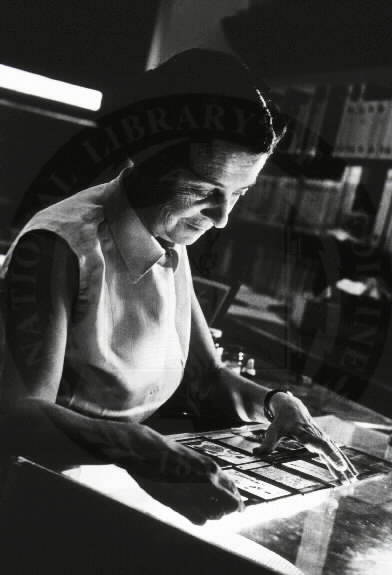Auguri Rita! The Future After 100 Years
An enormous cake with chocolate and strawberries: What could be a better way to celebrate my 100th birthday? This was probably Rita Levi-Montalcini’s thought as she sliced the first cake in a series of auspicious events and celebrations that started a week before April 22, the date when she will become the first Nobel laureate to reach the age of 100. The famous Italian Nobel prize winner shared her cake with the press, scientists, colleagues, and those who
attended at aceremony held in her honor by the European Brain Research Institute (EBRI). During this event she talked about her life and also announced that on her birthday in Rome there will be a scientific conference on the brain. Levi-Montalcini, who also serves as an Italian senator appointed for life, shared the 1986 Nobel Prize for Medicine with the American Stanley Cohen for discovering mechanisms that regulate the growth of cells and organs. “At 100, I have a mind that is superior – thanks to experience – than when I was 20,” she said during the party. Italy, and quite possibly the world, has never seen a scientist and a woman like her
Born into a well-to-do Jewish family in Turin in 1909, Levi-Montalcini fought hard for her career from the start. First, there was her domineering father who didn’t believe that women should aspire to higher education. Despite his opposition, she graduated with honors in medicine from the University of Turin just before the outbreak of World War II. Her first mentor was Giuseppe Levi, a prominent in neurohistologist at the University of Turin. (Neurohistology is a branch of neurology that deals with the minute structure of animal and plant tissues as discernible with a microscope). In her autobiography In Praise of Imperfection Levi-Montalcini refers to him as “the Master.” He was an outspoken antifascist, renowned for his alarming fits of rage. But he was also the man who introduced her to her first passion: the developing nervous system. Under Levi’s guidance, she developed a technique that represented the key to her own success, that of silver-staining nerve cells. In the late 1930s Mussolini imposed the racial laws which forced so many Jews, including Levi-Montalcini, to leave universities and go into hiding. She told the audience at the EBRI how after these anti-Jewish laws were passed, she had to quit the university and conduct research in an improvised laboratory in her bedroom at home. Food was so scarce, she said, that after experimenting on chicken embryos, she would cook and eat the remaining yolks.
“Above all, don’t fear difficult moments,” she said. “The best always comes from them. I should thank Mussolini for having declared me part of an inferior race. This led me to the joys of working, no longer at a university, but in a bedroom,” the scientist said. Between 1941 and 1943, Levi-Montalcini lived in a country cottage in the Piedmont region, and then went into hiding in Florence. After the Allied liberation of Italy in 1944, she worked as a doctor for refugees in Florence and in 1945 she returned to the University of Turin. Two years later she moved to Washington University in St. Louis, Missouri, becoming associate professor in 1956 and full professor from 1958 to 1977. During that period she became an American citizen. She then went back to Italy where she was appointed director of the Institute of Cell Biology of the Italian National Research Council in Rome in 1969, a position she held until her retirement in 1978. Among the many struggles that characterize her life, there was one in particular regarding her research that stands out. Part of the scientific establishment refused to believe in the existence of nerve growth factor (NGF), the discovery of which eventually won Levi-Montalcini the 1986 Nobel Prize in Physiology or Medicine, along with her colleague Stanley Cohen.
“That discovery was huge; it opened up a whole field of understanding how cells talk and listen to each other,” said neuroscientist Bill Mobley of Stanford University, an admirer for more than 30 years. Hundreds of growth factors are now known to exist and they affect almost all facets of biology.
Despite her age, Levi-Montalcini still works every day, wearing elegant outfits, with the hair stylishly coiffed and her hands perfectly manicured. Her mornings are dedicated to her namesake European Brain Research Institute (EBRI)–Rita Levi-Montalcini in the suburbs of Rome, while in the afternoons she goes downtown to the offices of an educational foundation for African women that she created in 1992.
Turning 100 is no reason to stop fighting. ““What I did in the past is not enough — there is only the future,” says Levi-Montalcini. She has never hesitated to use her senate position to push for better scientific research in the Italy. And today she has another important battle to fight, something very close to her heart: the survival of the EBRI, which she created in 2002, is now in financial jeopardy. During the celebration held at the EBRI, the new Nobel Hall was inaugurated and dedicated in her honor. Levi-Montalcini was asked if she felt moved by this tribute. “The only thing that still moves me is life. I am deeply moved because I was able to reach this goal after having lived a life feeling an authentic joy and continuous curiosity.” Her words addressed to an attentive audience reflected a spiritual testament to having high moral standards. “The absolute evil of our times,” she forcefully stated, “is to not believe in values.
It does not matter whether they are religious or secular. The younger generation must believe in something positive. Life deserves to be lived only if we believe in values, because they continue on after our deaths.” Rita Levi-Montalcini’s speech ended with a desire addressed to young people: “I wish them the same luck that led me to take no interest in myself, but to always show great attention towards everything around me, towards the world of science without neglecting the values of society.”
“And just think, I wasn’t born to be a scientist,” she added, a statement that surprised the audience. “I wanted to go to Africa to help people in need. As an adolescent, I dreamed of emulating Albert Schweitzer by helping to cure lepers. Now, in the final stage of my life, I can at last help those people who have been exploited for centuries. I can say that the only ideal I have ever worked for was to help others, and perhaps for this reason research has given me more than I could ever hope.”
After such an impressive speech given with customary simplicity, Rita Levi-Montalcini, with her white hair elegantly coifed and wearing a smart navy blue suit, raised a glass of sparkling wine and toasted her long life.
(Edited by Giulia Prestia)






































i-Italy
Facebook
Google+
This work may not be reproduced, in whole or in part, without prior written permission.
Questo lavoro non può essere riprodotto, in tutto o in parte, senza permesso scritto.